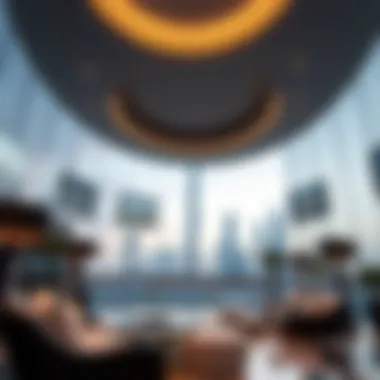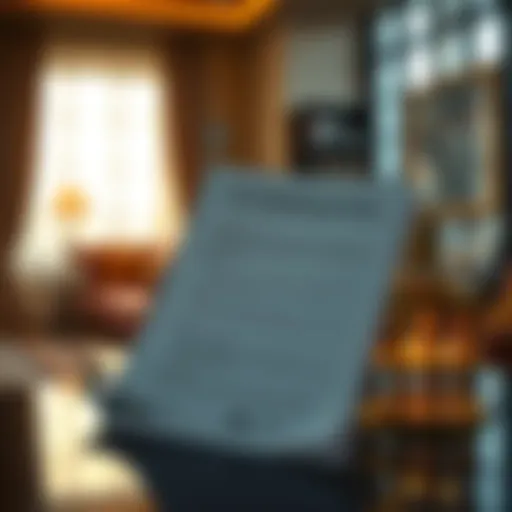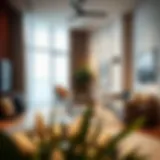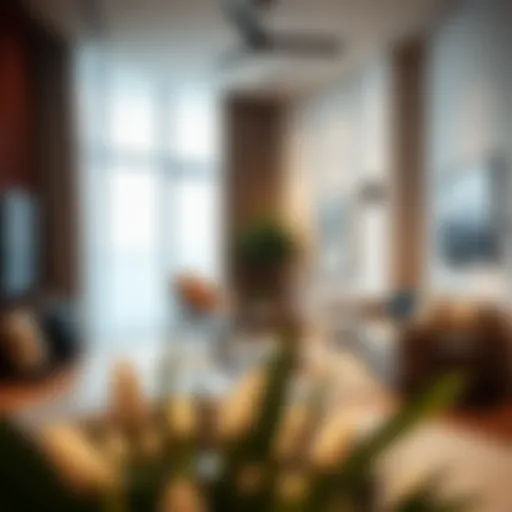Exploring Tower Building in Dubai's Landscape
Intro
The skyscrapers that dominate the skyline of Dubai are not mere architectural feats; they are a reflection of a rapidly evolving landscape blending art and science. These towering structures don't just scrape the sky; they narrate a story of ambition, engineering prowess, and socio-economic intricacies. As we've witnessed a hive of construction activity over the past few decades, the evolution of tower building in Dubai provides a fascinating insight into how cities can reinvent themselves, pushing the boundaries of what is possible.
In this exploration, we dive deep into the underlying elements that define Dubai's tower building trends. From the economic factors shaping current real estate prices to the anticipated directions the market is headed, we will analyze the essential frameworks that fuel this vertical growth. It’s like peeling back the layers of an onion, getting to the core of what makes the Dubai real estate sector tick. Whether you are an investor eyeing opportunities in this bustling market, a homeowner keen on understanding the value of your property, or a design aficionado captivated by cutting-edge skyscrapers, this article will provide a comprehensive and insightful narrative.
Let's embark on this journey, lifting the curtain on the art and science behind Dubai's prominent towers, where each is a testament to human ingenuity and economic strategy.
Understanding Tower Building
The construction of towering edifices is not just a feat of engineering; it represents a confluence of art, science, and socio-economic strategy. In the bustling metropolis of Dubai, where the skyline serves as a postcard of progress and ambition, understanding tower building offers invaluable insights into the forces shaping modern urban landscapes. This section delves into the definition, origins, and the multifaceted role that skyscrapers play within urban development.
Definition and Origins
Tower building refers to the architectural process of constructing high-rise structures that exceed certain height thresholds, typically characterized by their verticality and prominence. These skyscrapers began as a necessity to maximize limited land resources, especially in burgeoning urban environments. Their origins can be traced back to the late 19th century, when innovations like steel framing and elevators enabled architects to think tall.
The term skyscraper itself is often rooted in the American experience, but its principles have found a comfortable home in other parts of the world, notably Dubai. Here, the first building that could be classified as a skyscraper was the Sheikh Khalifa Tower, completed in 1979. Dubai’s unique position—sandwiched between tradition and modernity—has allowed it to redefine what a skyscraper can be. A blend of various architectural styles, richly influenced by both Eastern and Western designs, serves as a physical representation of Dubai’s ambitious identity.
Interestingly, tower building’s appeal transcends mere aesthetics. Psychologically, people are attracted to heights; there’s a sense of achievement associated with towering above others. Consequently, towers often become symbols of pride and prosperity for their locales, ultimately drawing in tourists, residents, and investors alike.
The Role of Skyscrapers in Urban Development
Skyscrapers do more than just scrape the sky; they are pivotal in shaping the functionality and vibrancy of cities. In Dubai, vertical structures enhance land use efficiency, accommodating more people and businesses in a limited geographical area. The resulting urban density leads to a bustling atmosphere, where various services and amenities are just a short elevator ride away.
These towering giants play a crucial role in urban planning by:
- Catalyzing Economic Growth: Each skyscraper serves as a hub for commercial activity. For example, the development of the Burj Khalifa not only attracted high-end investments but also transformed the adjoining area into a thriving tourist destination.
- Enhancing Infrastructure: As more skyscrapers rise, they necessitate the development of comprehensive infrastructure, including transport systems, public utilities, and green spaces that elevate quality of life for residents and business occupants.
- Promoting Sustainability: Modern skyscrapers are increasingly designed with sustainable practices in mind, such as energy-efficient systems and green roofs, contributing to eco-friendly urban growth.
"Skyscrapers symbolize humanity's relationship with space and ambition, reflecting not just what we can build, but also who we aspire to be."
This exploration into understanding tower building lays the groundwork for grasping the complexities involved in constructing Dubai's iconic structures and the critical socio-economic impacts they herald.
Historical Context of Tower Construction in Dubai
The landscape of modern Dubai tells a vibrant story, with soaring towers punctuating the skyline. Understanding the historical context of tower construction in Dubai provides valuable insights into not only the architectural trends that have shaped the city but also the socio-economic developments that have propelled it onto the world stage. The juxtaposition of ancient and modern structures within Dubai embodies the city's rapid growth and its ambition to become a global hub.
Diving into the history reveals a narrative of adaptation and vision—factors that are pivotal for investors looking for long-term growth opportunities in the region. The evolution of tower construction is not just about aesthetics or height; it encapsulates a deep understanding of cultural influences, economic demands, and engineering advancements that have come together in what we see today.
Early Beginnings and Architectural Influences
In the early days, Dubai's architecture was largely influenced by its geographical context and cultural heritage. The city originally bore low-rise buildings typically constructed from coral stone and mud, structures that suited the arid climate. With the discovery of oil in the 1960s, Dubai's financial landscape transformed dramatically. This shift marked the beginning of a new architectural era where ambitions soared as high as the towers that would soon scrape the sky.
During the 1970s and 80s, architectural styles began to lean more towards modernism, akin to what was happening globally. Local architects infused their designs with elements inspired by Islamic art and traditional styles. These are easily observable in the wind towers and courtyards used for passive cooling. The blend of modern and traditional not only suited the environment but also connected the new Dubai with its historical roots.
As Dubai entered the 21st century, further architectural influences emerged. The increased globalization brought with it a potpourri of designs from West to East. The iconic Burj Khalifa, completed in 2010, is a perfect example. Standing tall at 828 meters, it is not merely a skyscraper but a feat of modern engineering. It draws its design elements from traditional Islamic architecture, showcasing how diverse influences come together in the spirit of innovation.
The Skyscraper Boom in the Twenty-First Century


The new millennium saw an explosive growth in skyscraper construction, matching the country's rapid urbanization and economic growth. The phrase "if you build it, they will come" resonates with developers here. Investing in towers became emblematic of wealth and ambition, evidenced by initiatives like the Dubailand project, which turned imaginations into concrete reality.
Between 2000 and 2010, Dubai positioned itself as a laboratory for experimental architecture. The Burj Al Arab, often called the world's only 7-star hotel, rose directly from the sea, symbolizing luxury and excess. Developers started to incorporate innovative building materials and technologies. These efforts culminated in an array of stunning designs characterized by unique geometric forms and environmental consciousness.
A diverse set of architects from across the globe contributed their vision to Dubai, resulting in a skyline that defies conventions. Commercial and residential skyscrapers began to dominate, each telling its own story of entrepreneurship and vision. With such rapid growth, however, comes a host of challenges. From the energy demands of these tall structures to the implications for urban planning, the runway to the future is far from straight.
"Dubai's shift to verticality is not just a construction trend, it's a declaration of ambitions and capabilities."
The current wave of skyscrapers encapsulates advancements in engineering and technology. High-performance materials support greater heights while ensuring structural integrity, allowing architects to think outside the box. The ability to adapt to past influences while catering to present and future demands illustrates the depth of Dubai’s architectural narrative.
As the urban environment continues to evolve, understanding the historical context of tower construction becomes crucial not only for appreciating the magnificent skyline but also for recognizing the roots of the ambition that drives Dubai forward. Investors keen on this market must understand how these influences play a role in shaping property values and urban life.
Engineering Challenges of Height
Building towers in Dubai presents a unique set of engineering challenges that professionals must navigate. As structures reach astounding heights, several considerations emerge, demanding innovative solutions and meticulous planning. The importance of understanding these challenges lies not only in safety but also in the longevity and functionality of the buildings. Here, we will examine crucial elements affecting tower design and construction in this vibrant city.
Structural Integrity and Materials Used
When designing towers, structural integrity is paramount. Engineers must choose materials that can withstand the immense loads and stresses that skyscrapers encounter. In Dubai, where the climate can be harsh, the materials used must also resist temperature fluctuations and ensure durability over time.
- Concrete and steel are two primary materials utilized in high-rise constructions, offering the strength required for vertical growth. High-strength concrete, for instance, is favored for its ability to bear significant weight and resist compression. Meanwhile, steel, known for its flexibility, is essential in allowing buildings to sway during high winds.
- Modern innovations have led to the development of composite materials that combine steel and reinforced concrete, further enhancing the structural capacity of towers. This combination helps mitigate potential failures by distributing loads more evenly across the structure.
In Dubai’s intense environment, the choice of materials also impacts thermal efficiency. By selecting materials that reduce heat absorption, buildings can achieve a better energy performance:
"The choice of materials is crucial not only for architectural aesthetics but also for the building's overall sustainability."
Wind Resistance and Earthquake Protection
With Dubai’s towers reaching greater heights, wind resistance emerges as a towering concern. Engineers employ sophisticated wind tunnel testing during the design phase to understand how the structure will react to wind forces.
- Buildings like the Burj Khalifa have incorporated aerodynamic shapes to reduce wind resistance. This design allows them to slice through the wind rather than presenting a flat surface that would generate pressure.
- Additionally, incorporating damping systems can effectively dissipate wind energy. These systems typically use devices that absorb vibrations, preventing uncomfortable sway and ensuring the comfort of the occupants.
Earthquake protection, although not a frequent occurrence in Dubai, is still an essential aspect of tower engineering. The seismic design incorporates:
- Flexible structural components that allow for movement without compromising integrity.
- Base isolation techniques to prevent shock waves from traveling through the building.
Safety Standards in Tower Design
Safety in tower construction is not a matter that can be sidelined. A robust framework of safety standards ensures that buildings can withstand both physical risks and unexpected events.
- Regulatory bodies in Dubai have established comprehensive codes that govern structural design, fire safety, and emergency evacuation. Adhering to these regulations enhances public safety and fosters trust among stakeholders.
- Moreover, the integration of advanced detection systems is now standard in many high-rise buildings. These systems monitor structural health and environmental variables, providing real-time data that can preemptively address issues.
In essence, the engineering challenges of height in Dubai necessitate a multifaceted approach. The interplay of structural integrity, wind resistance, and safety standards ensures that these towering edifices stand as a testament to human ingenuity and ambition.
Iconic Towers in Dubai
The skyline of Dubai is a breathtaking tapestry woven together by iconic towers that transcend mere verticality. In this bustling metropolis, each tower tells its own story, representing a slice of luxury, innovation, and architectural brilliance. Understanding the significance of these structures goes beyond listing their practical benefits; it's about recognizing their role as cultural symbols, economic drivers, and bold statements of human ingenuity.
Burj Khalifa: A Defining Landmark


The Burj Khalifa stands as a beacon in the desert, soaring 828 meters into the sky. It's not just a building; it’s a monumental feat of engineering that captures the imagination. This towering structure was designed by the renowned architecture firm Skidmore, Owings & Merrill and remains the tallest man-made structure in the world since its completion in 2010.
Visitors from across the globe flock to its observation deck for a bird's-eye view of the sprawling city below. Beyond its impressive height, the Burj Khalifa has cultural significance. It embodies the spirit of Dubai's quest to push boundaries and redefine possibilities in architecture and urban planning. However, maintaining such a landmark comes with challenges, including regular maintenance and cleaning of its curved glass facade. These factors emphasize the importance of investing in robust building management systems.
"The Burj Khalifa is not merely a structure, but a symbol of hope and ambition for the city of Dubai."
The Address Downtown: Luxury Meets Design
Nestled against the backdrop of Burj Khalifa, The Address Downtown is an exemplar of luxury living. This five-star hotel, with its elegant design and enchanting views of both the tower and the Dubai Fountain, captivates the hearts of those who step into its lavish confines. Designed by the famed architect, BSBG, the Address combines sophistication with functionality, attracting high-profile guests, tourists, and long-term residents alike.
The building's integration of upscale dining options, state-of-the-art fitness facilities, and a world-class spa ensures that every aspect of luxury is catered to. This synergy of lavish living and strategic positioning also makes it an attractive lure for investors. With property prices in the downtown area steadily rising, The Address Downtown stands as a testament to profitable investment opportunities entwined with lifestyle choices.
Dubai Marina: A Skyline Transforming Experience
Dubai Marina has redefined the face of urban living in Dubai, with its cluster of skyscrapers mirroring sophistication and opulence. Constructed in a purpose-built waterfront community, it features residential towers, hotels, and leisure facilities that harmonize with the serene waters of the marina. The architecture showcases a mix of modernity and innovation, providing inhabitants and visitors with a vibrant lifestyle.
As a lifestyle hub, Dubai Marina has become a focal point for both locals and expatriates. Its well-planned layout complements key activity areas such as cafes, restaurants, and retail spaces, making it a prime location for both residential and commercial efforts. Furthermore, the panoramic waterfront views enhance the allure, presenting unique opportunities for luxury property investments.
Understanding the evolution of these iconic structures is essential. They are the backbone of Dubai's ambition to become a world-class city, and their ongoing success is a reflection of the continuous evolution in architectural practices, economic strategies, and urban lifestyle choices. The towers of Dubai are not mere buildings; they are the very essence of the city's identity.
Architectural Innovations in Tower Design
In the ever-evolving landscape of architectural design, the innovations seen in tower construction in Dubai often leave observers in awe. These advancements reflect not just the creativity of architects and engineers, but also the pressing need to marry aesthetic appeal with functionality. As the city aspires to redefine its skyline, understanding architectural innovations becomes crucial for stakeholders at all levels—whether they are investors looking at the potential of high-rises or designers aiming to push boundaries.
Sustainable Practices in Tower Construction
Sustainability in architecture is more than just a buzzword; it's become a necessity in today’s world, especially in a city like Dubai where the climate is arid. Towers now reflect this commitment to eco-friendly building practices.
- Energy Efficiency: Modern towers are designed with energy-efficient systems. Double-glazed windows, for instance, minimize heat gain while maximizing natural light. This reduces reliance on artificial lighting and air conditioning.
- Water Conservation: Innovative plumbing systems capture and recycle greywater, enhancing water efficiency. Towers like the Burj Khalifa have implemented systems that repurpose water for irrigation, helping to maintain green spaces surrounding them.
- Sustainable Materials: Materials sourced from local suppliers not only cut down on transportation emissions but also create a sense of place. High-performance insulated concrete forms are increasingly used, ensuring durability while being environmentally sound.
"Green architecture is not just a trend; it’s an investment toward a sustainable future that appeals to conscious buyers and investors."
By integrating sustainability deeply into their structures, these towers not only enhance their marketability but also set a benchmark for global standards in skyscraper design.
Smart Towers: Integration of Technology
In an age where technology seamlessly intertwines with every aspect of life, the skyscrapers of Dubai are no exception. Smart towers utilize cutting-edge technology to create spaces that are not only more efficient but also more livable.
- Building Management Systems (BMS): These systems allow for remote monitoring and control of various building functions, from heating and cooling to security systems. For instance, The Address Downtown employs such technology to ensure optimal comfort and safety for its inhabitants.
- Automation: Elevators connected with smart technology can predict usage patterns, thereby optimizing efficiency during peak times. Imagine a tower where, during busy hours, elevators prioritize calling the floors with the highest traffic, significantly reducing wait times.
- Connectivity: With reliable Wi-Fi and smart home features, residents can control their living environments from their devices. This connectivity enhances the overall living experience, making properties more appealing to tech-savvy individuals.
As the demand for smart living spaces grows, it’s clear that integrating technology isn't just about convenience—it’s about future-proofing buildings for generations to come.
In summary, innovations in tower design in Dubai provide not just insights into what's possible today but also hint at a future where architecture will increasingly integrate with its environment and community needs. These developments are instrumental in reshaping how we think about urban spaces, giving both life and character to the city’s iconic skyline.
Social and Economic Impacts of Tower Building
Building towers, particularly in a city like Dubai, goes beyond aesthetics or creating a physical structure that touches the sky. It's an intricate dance between economic assumptions, societal shifts, and urban design. As we move deeper into this realm, we see how social dynamics and economic landscapes get reshaped through vertical growth. These towering structures often become symbols of progress, reflecting not just wealth, but also community identity and interaction.
Urban Density and Land Use Efficiency


Dubai's skyline is more than an architectural feat; it embodies a significant solution to urban density. As populations soar and space becomes scarce, tall buildings provide a clever way to utilize limited land effectively.
- Maximizing Space: By building upwards, developers can create dense residential and commercial environments. This translation of limited ground area into multi-storey towers means that more individuals can live and work in proximity.
- Reducing Urban Sprawl: This vertical approach helps to stave off the ever-encroaching urban sprawl that can plague cities. Less sprawl translates to efficiency in transport, utilities, and public services, making life simpler for residents.
- Mixed-Use Developments: Many towers are designed with multiple functionalities. They incorporate living spaces, offices, and retail units within the same structure. This design fosters community interactions in a way that promotes a vibrant urban atmosphere.
Opting for tall buildings like the Burj Khalifa or The Address Downtown not only offers breathtaking views but addresses housing shortages and enhances livability in a growing metropolis. The proof is in the pudding: as more folks flock to Dubai for work or leisure, the socio-economic fabric of the city evolves without stretching its borders too thin.
Influence on Property Values and Investment Trends
As the saying goes, "location, location, location," but in Dubai, the mantra has morphed into "height, height, height." The push for towering edifices has had a significant impact on property values and investment opportunities in the area.
- Perceived Value: High-rise developments are often viewed as privileged spaces. The allure of panoramic views and lavish amenities tied to tower living drives demand, subsequently inflating property values.
- Investment Attraction: Investors keen on high returns frequently flock to towering projects. Such developments often promise returns through both rental and resale opportunities, with skyscrapers becoming hot commodities.
- Market Shifts: As demand for tower living grows, so too does the necessity for unique architectural and design features. This healthy competition among developers invites innovation, potentially leading to even greater investment opportunities down the road.
The economic impact of tall buildings in Dubai cannot be understated; they are engines of growth, providing job opportunities, increasing tourism, and drawing investors from every corner of the globe.
In summary, the intersection of societal needs and economic opportunity in tower building is a rich narrative, reflective of both global urbanization trends and local imperatives. As Dubai continues to rise, both literally and metaphorically, it becomes clear that the stakes are higher than ever in the world of skyscrapers.
Future Trends in Tower Development
In the ever-evolving skyline of Dubai, future trends in tower development take center stage, serving as a compass for investors, architects, and city planners alike. The significance of this topic lies in the anticipation of how emerging trends will shape not just the aesthetic appeal of the city but also its functionality, sustainability, and economic potential. With the world focusing more on environmental concerns and efficient land use, Dubai stands to redefine the essence of high-rise buildings through innovative practices.
Emerging Technologies and Their Impact
The role of technology in tower development cannot be overstated. Cutting-edge innovations are revolutionizing how skyscrapers are designed, constructed, and maintained. Technologies such as Building Information Modeling (BIM) enable architects and engineers to create detailed digital simulations before a single brick is laid. This meticulous planning can save time and resources while reducing errors in the construction phase.
Moreover, advancements in materials science, like ultra-lightweight concrete and smart glass, lead to some very impressive structures. For instance, adaptive façades that adjust to sunlight exposure can drastically reduce energy consumption. Some towers now incorporate integrated solar panels into their design, contributing to sustainable energy goals while providing aesthetic value.#
Another frontier involves automation and artificial intelligence. Smart buildings are equipped with systems that monitor energy usage and optimize resources automatically. This not only minimizes waste but also positions Dubai as a frontrunner in smart city initiatives.
"Emerging technologies are not just about aesthetics; they embody efficiency and sustainability in tower building."
The Shift Towards Adaptive Reuse of Older Structures
As new towers scrape the sky, another trend surfaces: the adaptive reuse of existing structures. With urban landscapes continually evolving, repurposing older buildings offers a practical approach to maintaining heritage while meeting contemporary needs. This practice is proving to be not only environmentally sound but also economically advantageous.
Transforming older structures into mixed-use developments has gained traction. A once dilapidated warehouse may become a vibrant loft space or office complex, ensuring that the past is integrated into the future. This kind of innovation fosters a greater sense of community, creating places that people want to inhabit rather than just office spaces or living quarters.
Investors and developers are increasingly drawn to projects focusing on adaptive reuse. This investment model significantly reduces the carbon footprint associated with demolition and new construction. Plus, it often activates previously neglected areas, breathing new life into neighborhoods.
Culmination: The Evolving Landscape of Tower Building
The world of tower building in Dubai is not just about erecting skyscrapers. It's a microcosm of the shifting tides of urban living, economy, and architecture. This article encapsulates various factors that contribute to the distinctiveness of Dubai's skyline and, by extension, its real estate market. As we've seen, has intertwined with local culture, economic strategies, and global trends, leading to a continual evolution that reflects both ambition and ingenuity.
Summarizing Key Insights
In digging into the layers of building in Dubai, several salient points emerge:
- Historical Evolution: The rapid transformation from modest structures to grand towers illustrates a broader shift in Dubai's identity. The Burj Khalifa, for example, serves as a beacon of aspiration and economic potential. It stands not just as a height milestone, but as symbolic of what is possible when creativity meets opportunity.
- Engineering and Innovation: The sheer engineering challenges associated with these towering structures reflect the pinnacle of human attainment in design technologies. Innovative methods, such as carbon-fiber materials and enhanced wind resistance techniques, showcase a forward-thinking mindset that addresses both aesthetic and functional needs.
- Economic Impact: The role of towers in enhancing land value and attracting investments cannot be overstated. With each high-rise that’s completed, the perception of the area shifts, stimulating further growth in commercial activity and residential appeal.
In summary, the intricate interplay between culture, technology, and economics defines how towers in Dubai are not just structures, but integral components of a constantly evolving landscape.
Anticipating Future Developments
Looking forward, the future of tower development in Dubai holds intriguing prospects:
- Sustainable Practices: As awareness of environmental issues grows, we can expect a push towards green building technologies. This includes energy-efficient designs, effective waste management systems, and the integration of renewable resources.
- Technological Integration: The rise of smart technologies in construction points toward an enhanced living experience within these towers. With integrated IOT systems, residents can expect greater security, convenience, and energy management capabilities.
- Adaptive Reuse: Trend toward repurposing existing structures offers a sustainable option for urban development. This practice can keep the cultural integrity of the city intact while providing new functionality.















